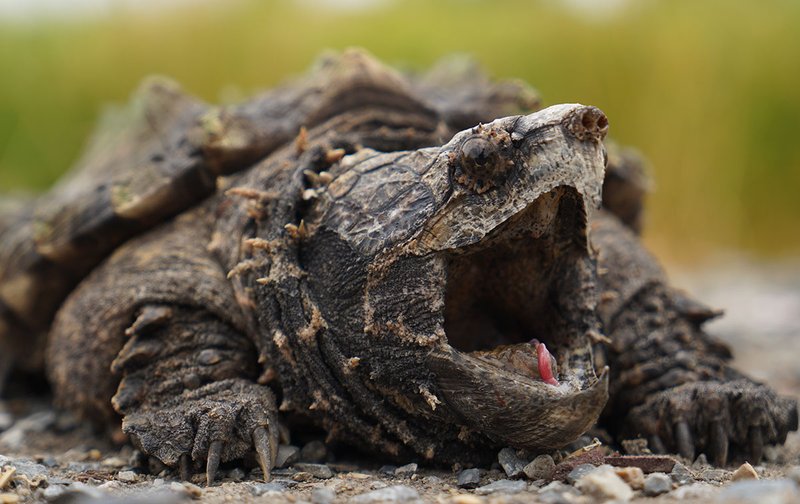
Here’s the thing: snapping turtles are not the cuddly type. While they certainly don’t go around hunting humans, they can bite and they’re surprisingly fast when provoked. So, let’s dive headfirst into this topic, looking at what makes these creatures unique and how we can safely coexist with them.
Understanding Snapping Turtles
Snapping turtles are fascinating creatures belonging to the family Chelydridae. They’re primarily found in North America, often inhabiting freshwater bodies like ponds, lakes, and rivers. With their large size—sometimes weighing over 30 pounds and measuring up to 18 inches in shell length—they’re some of the biggest turtles around.
These turtles have a distinctively rough, rugged appearance. Their shells are often covered in algae, allowing them to blend seamlessly into their watery environment. But it’s not just their looks that are striking. Snapping turtles are equipped with powerful jaws that can deliver a surprisingly fierce bite, earning them a reputation in the animal kingdom.
Interestingly, snapping turtles are omnivores, which means their diet is quite varied. They munch on aquatic plants, insects, and even small fish or amphibians. This adaptability in diet contributes to their success as a species, but it also means they can be found in various habitats, making encounters with humans more likely.
How Dangerous Are Snapping Turtles?
While it might seem that snapping turtles are constantly on the attack, that’s not quite the case. Generally, these turtles are quite shy and prefer to avoid confrontation. However, if they feel threatened, they can react aggressively. Just like you’d defend yourself if someone cornered you, snapping turtles do the same.
Their bite can be incredibly strong, capable of breaking through small bones. Most human injuries from snapping turtles occur when someone tries to handle them or gets too close. So, it’s crucial to respect their space. Remember, they’re more interested in swimming away than attacking.
When left alone, snapping turtles are rarely a threat. They often stay submerged for long periods, only surfacing to breathe or bask in the sun. But if you do cross paths with one, it’s wise to keep a safe distance. Honestly, observing them from afar is the best way to appreciate their beauty without risking injury.
Common Myths About Snapping Turtles
Many myths surround snapping turtles, and it’s easy to see why. From tales of them attacking boats to legends about them dragging people underwater, these stories can make anyone wary. But most of these ideas are exaggerated or simply untrue.
One common myth is that snapping turtles can leap out of the water to attack. While they are surprisingly agile in water, they don’t jump like some fish or frogs. Instead, they usually stay low and only rise to the surface. If they’re swimming towards you, it’s probably just curiosity, not a predatory intent.
Another misconception is that snapping turtles will chase you if disturbed. In reality, they’re more likely to retreat into the water. If they feel threatened, they might hiss or display defensive behaviors, but they usually want to escape. So, if you see one, don’t panic. Just back away slowly, and let them be.
What to Do If You Encounter a Snapping Turtle
If you find yourself face-to-face with a snapping turtle, the best course of action is to remain calm. Here are some steps you can follow:
- Keep Your Distance: Stay at least a few feet away. This not only keeps you safe but also allows the turtle to feel secure.
- Observe: Enjoy watching the turtle from a safe space. They’re interesting creatures, and observing their behavior can be quite rewarding.
- Don’t Feed Them: Feeding wild turtles can disrupt their natural diet and behaviors. Plus, it brings them too close to humans, which can lead to dangerous encounters.
- Leave Them Alone: If a snapping turtle is crossing a road or in an area where it shouldn’t be, it’s best to steer clear. If it’s safe to do so, you can help by gently guiding it in the right direction using a stick—but keep your hands away from its jaws!
How to Handle a Snapping Turtle Safely
If you ever need to handle a snapping turtle—perhaps during a wildlife rescue or if it’s in a dangerous spot—keep these tips in mind:
- Use a Towel or Cloth: To safely lift a turtle, use a towel to cover its eyes. This can help calm the turtle and minimize its reaction to being picked up.
- Always Lift from the Back: If necessary, grab the turtle from the back of its shell. Avoid the front where its head is, as this is where the powerful jaws are!
- Be Mindful of Its Tail: Snapping turtles can use their tails for balance, so don’t hold them by the tail. This can injure them.
It’s important to remember that handling wildlife should be done with caution and respect. Always prioritize the turtle’s well-being and your safety.
In summary, snapping turtles are fascinating creatures that deserve our respect and understanding. While they can be dangerous if provoked, they typically prefer to avoid humans altogether. Remember, these reptiles are not out to get you; they just want to live their lives peacefully in their aquatic habitats.
The key to enjoying these remarkable animals lies in knowing how to interact with them—and when to simply stand back and observe. By giving snapping turtles the space they need, we can coexist peacefully with these ancient reptiles. So next time you’re near a pond and spot a snapping turtle, take a moment to appreciate it from a distance. Trust me, it’s a sight worth seeing!

